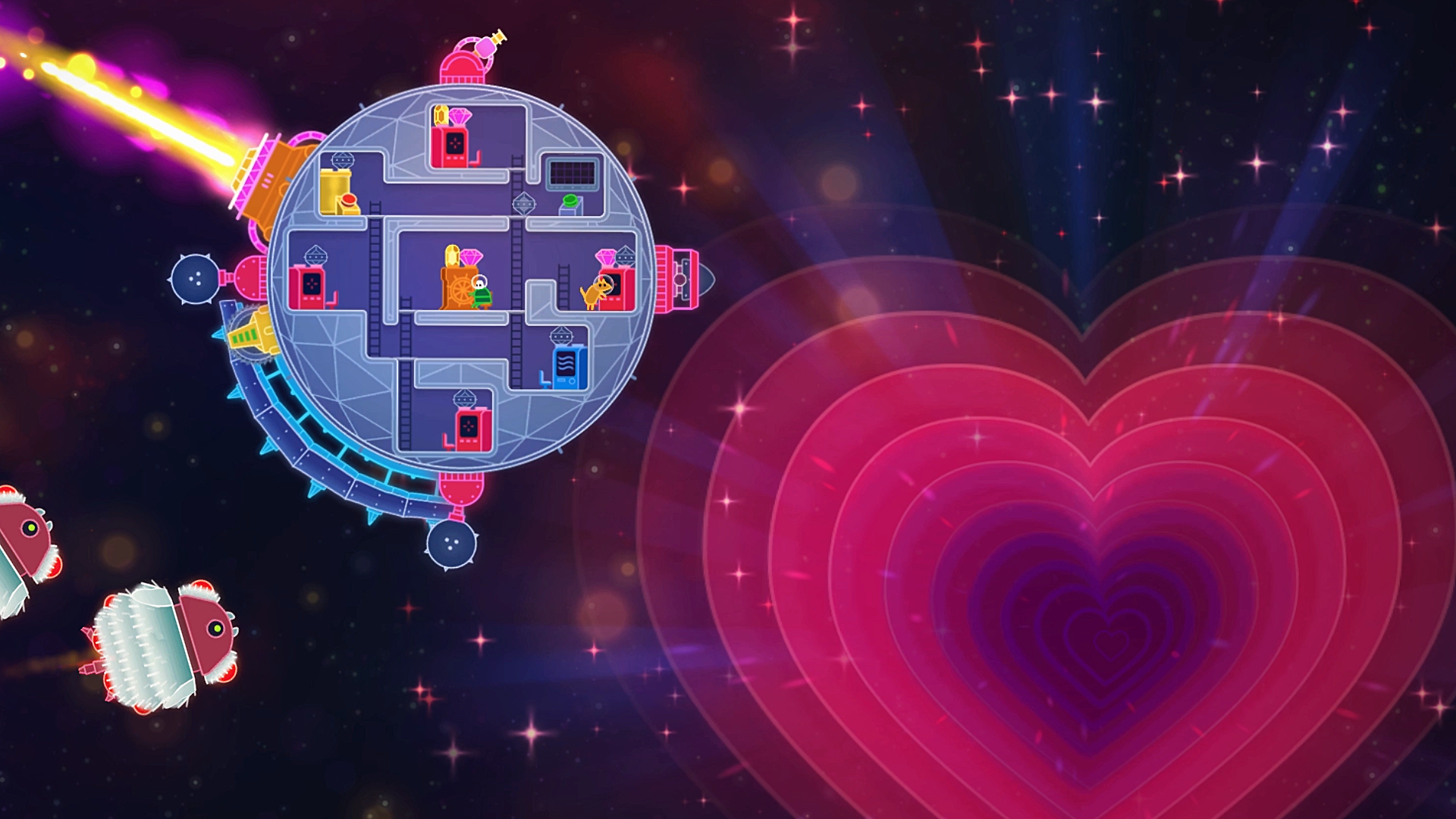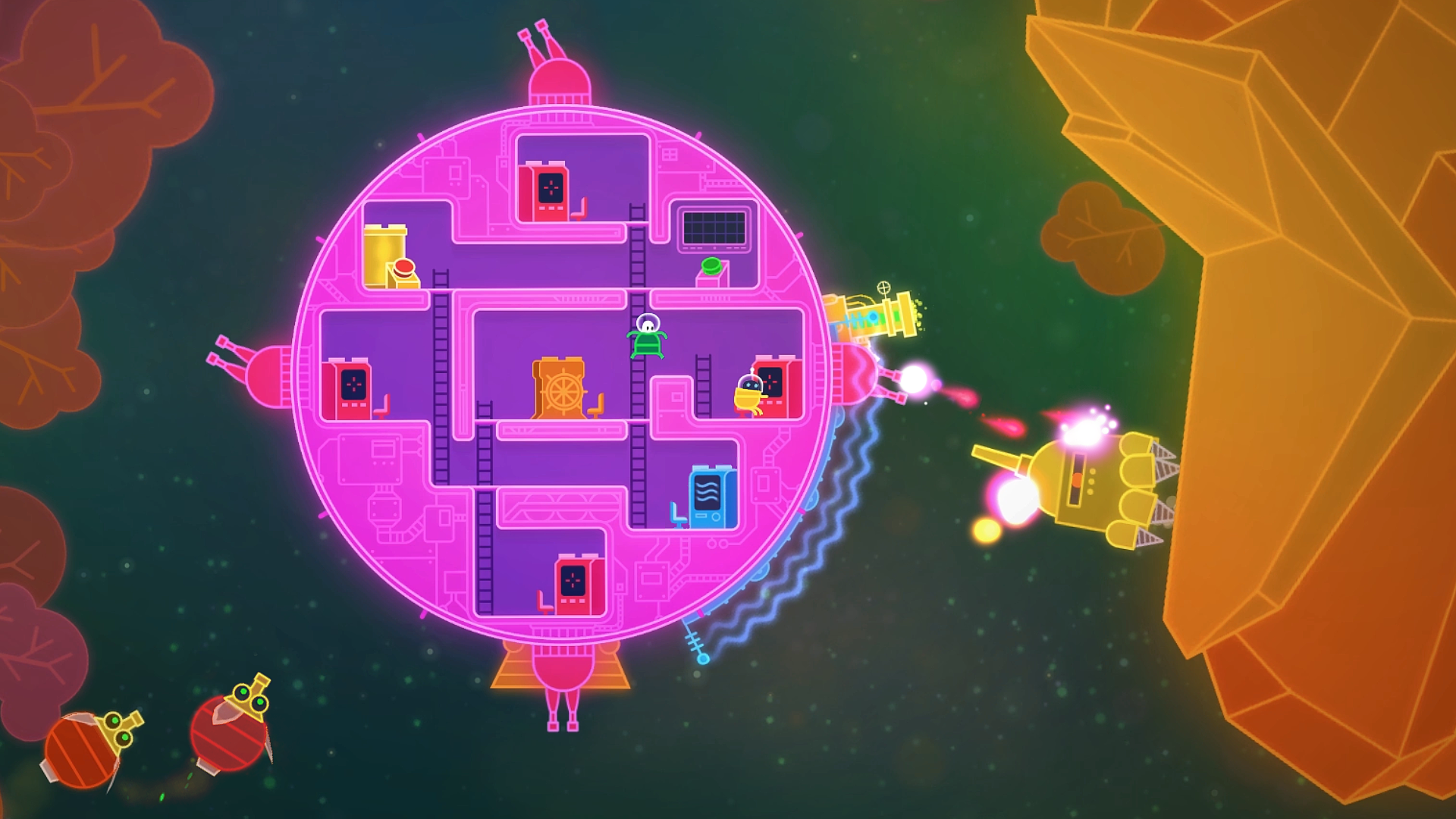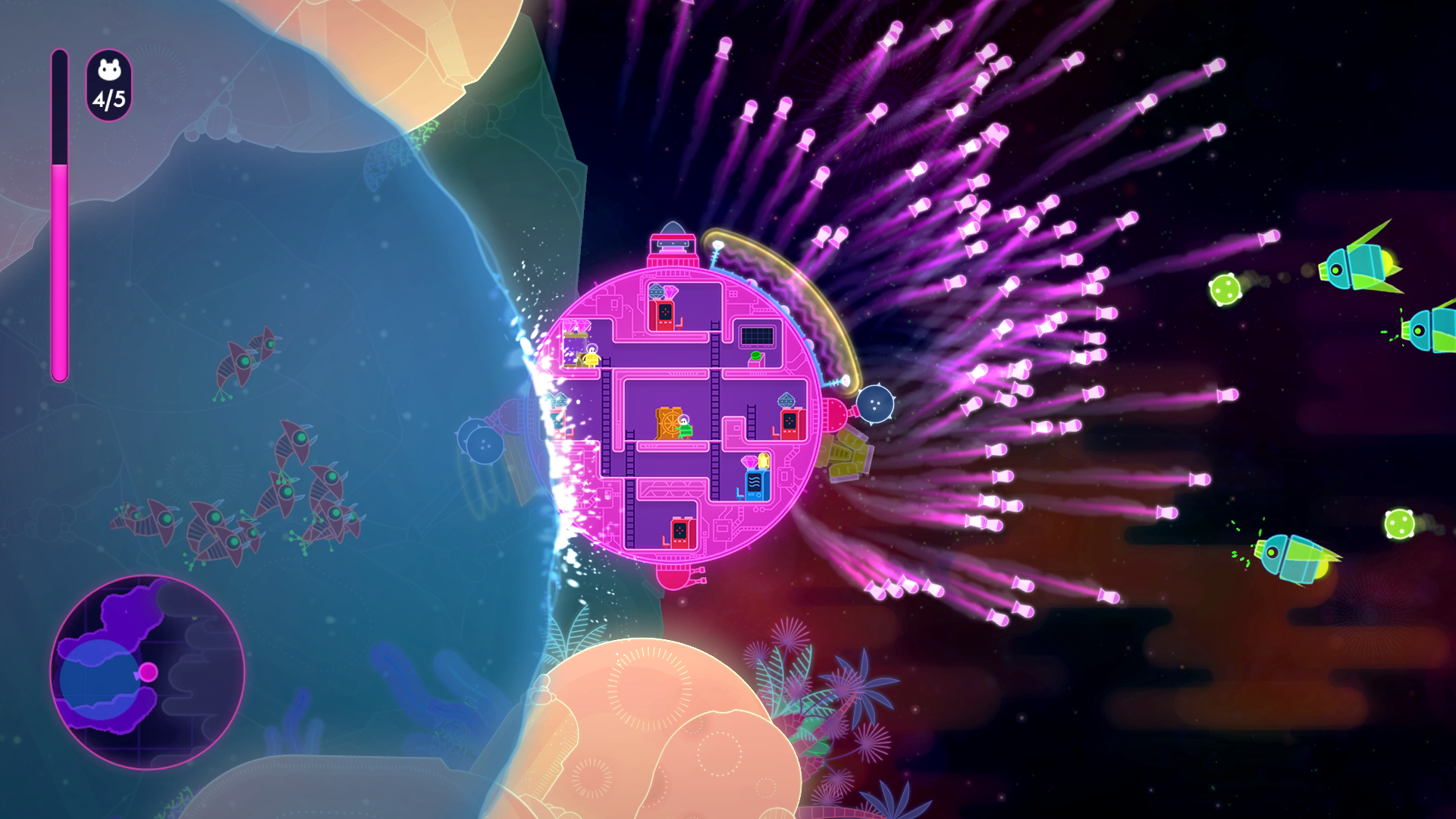Lovers in a Dangerous Spacetime: Teaching and Testing Cooperative Skills

This week I’m writing about Lovers in a Dangerous Spacetime. It’s available on Mac, Windows, Linux, and Xbox One. You can buy the game on its official website, gog.com, the Humble Store, or Steam. I highly recommend you do so if you enjoy local co-op games. I played it with my brother on a Windows PC with 2 connected Xbox 360 controllers. I really can’t imagine playing it alone, but that doesn’t mean you shouldn’t try if the game looks cool to you and you can’t find a partner for it. (It’s not actually about lovers or romance, so the game itself isn’t at all awkward to play with a friend or family member.)
Basic Mechanics
The game takes place inside a circular space ship. Players must navigate their ship through space to rescue at least five adorable critters from every level, while avoiding various traps and unfriendly space monsters who come from all sides. The ship has four rotating turrets, an emergency gun, a shield, an engine, and a map. Players do not control these parts directly, but by guiding their player characters to corresponding consoles at different locations inside the ship, and controlling the consoles.

Each part is inherently limited. Turrets can rotate to aim, but only so much as to cover about a third of the ship’s circumference, extending from the turret’s quadrant. Because of this, players must engage enemies by first maneuvering through the ship to reach the proper turret. The engine powers your ship’s movement from any given direction. The shield can be placed to cover any side of the ship, but it, too, must be piloted by a player, limiting the group’s capability for combat or evasive movement using the engine. Since any given part must be piloted to be of any use, the game constantly engages teams in resource management. There are only two of you, and your alien astronauts are your most valuable resource. Can you both be in the right place at the right time, all the time?
This mechanical focus on cooperative resource management require players to learn four core skills in order to be successful. These are the same core skills which are required for success in any team endeavor, be it athletic, professional, or in a video game.
Communication
This is perhaps the most important skill when playing Lovers in a Dangerous Spacetime. You need to keep your partner appraised of your status. If you both see a wave of enemies coming from the left, which one of you will take care of it? Without proper communication, you might reflexively head to address the problem from the opposite side of the ship while your partner was easily in range all along. It’s easy to step on each other’s toes and waste time or put your ship in danger by forgetting to communicate.
Mechanics that promote communication
Circular field of combat
Enemies can come from anywhere, forcing you to move between the four turrets quite frequently. They can also approach from many sides at once. During ambush sequences after players find a trapped critter, enemies spawn to surround the ship from all sides. In situations such as this, it becomes crucial to communicate with your partner to coordinate who will manage which turrets at any given time, or who will take the shield. Failure to do so will leave sections of the ship undefended, allowing enemies to attack and sometimes destroy your ship, forcing the players to start the level over.
The engine/turret combo
It is a common tactic to leave one partner on the engine and another managing all 4 turrets. This combination is especially suited for traversing long distances on the map in pursuit of a goal. The turret consoles are separated from each other by a platforming maze of walls and ladders, albeit a simple one, which the fighter character must traverse in order to fire at enemies on a different side of the ship. Because of this, the fighter partner needs to give precise directions to the pilot to place the ship in the optimal position for managing incoming threats while minimizing delay between turret switches.
Partner brawls
If either player ever attempts to use a part of the ship which their partner is already using, the two players engage in a brief fight, after which the new pilot takes control of the part, kicking the old pilot off. During this brawl, both players lose control for a short time. Making this mistake during emergencies can put your team further in danger, so you must take care to communicate with your partner to avoid overlapping on a part of the ship when it could be fatal.
Awareness
Conversely, sometimes you need to know what’s going on without any communication. Things get hectic, and it’s not always possible to stay on top of a situation while also understanding your partner’s place in it. At times like this you need awareness.
Mechanics that promote awareness
Partner brawls
This mechanic promotes awareness equally as well as it does communication. Partner brawls can be avoided through simple caution, if players make sure to watch their partners’ locations carefully and stay on different consoles.
The shield
While running the shield and being attacked on all sides, it’s your job to know which turret your partner is firing, and defend on the opposite side so as to avoid being redundant with your resources. Because the shield can be moved anywhere from the same console, it is usually much simpler to move the shield than to force the gunner to run around the ship, and the gunner is more focused on enemies outside the ship, so it falls to the shield commander to be aware of many factors at once.
The radar
A radar is always visible in the bottom-left corner of the screen, showing objects, traps, and enemies within a short range outside what is visible on the screen. The radar’s main functions are to give advanced warning of approaching enemies, and to avoid traps and dead ends. Because the radar is constantly visible, and tucked outside of players’ region of visual interest, players must multitask to take advantage of it. This increases the usefulness of awareness, while also turning it into a challenge which players must always keep in the corner of their minds while dealing with more attention-grabbing problems. The radar is both a tool and a test for awareness.
The Jelly Roll
The need to be aware of your partner’s position is highly exaggerated while playing with one of the game’s unlockable alternate ships, The Jelly Roll. The Jelly Roll sports a reduced count of 3 turrets, but its engine has the ability to rotate your entire ship in either direction. It’s hard to overstate how disorienting this ability is, and it’s absolutely crucial to know where your partner is while working the engine, so that your rotations don’t move your partner away from the place they need to be. It’s a pretty delightful challenge.
Planning
Planning should be self-explanatory. The game requires you to work as a team with something resembling an overarching strategy: what you’re doing, and how.
Mechanics that promote planning
Upgrade gems
Every controllable part of your ship (excluding only the map) can be fitted with various gems you pick up during exploration of a level. There are three gem types:
- Power gems. These are used to give your ship parts generic upgrades. Turrets fire faster; the shield covers a wider range; the engine becomes stronger and gains a limited boost ability.
- Metal gems. These make your ship parts, well, metal. Turrets become spiky flails you can swing at crowds of enemies; the shield becomes larger, yet more slow and cumbersome; the engine now emits a stream of ninja stars.
- Beam gems. These give your ship lasers. Turrets gain a laser sight and fire beams which pierce through lines of enemies; the shield reflects projectiles from your enemies; the engine now wields a powerful laser discharge.
Each gem type has its own pros and cons. Power gems can be relied on to improve your ship without drawbacks, but the power they lend is much less than certain upgrades which might bring about occasional inconvenience. Metal gems give you stronger abilities with less flexibility and slower control. Beam abilities take longer to recharge than normal ones, but can eradicate many enemies at once and deal more damage. Beams of different types can also be combined to form even more exotic upgrades, such as the power missile (power gem + metal gem) which can be guided and launched at high speed, exploding on impact. Because every upgrade comes with strengths and drawbacks, it is important for players to experiment to discover which upgrades they prefer, and where they can best be placed. An overall strategy for upgrade placement can greatly increase chances of success, especially when developed in respect to a level’s unique challenges.
Boss battles
Bosses are difficult to beat without losing at least once. After learning the patterns and challenges presented by a boss, players can form a plan of attack to increase their chances of survival next time.
The map
One of the consoles present in your ship opens a map showing the entire level. Parts of the map you haven’t seen yet are obscured by clouds, and can be revealed by exploring those parts or by gathering map data from boxes found throughout the level. The mapping console allows you to locate your goals on the map and chart paths through the safest and most efficient routes to reach them. Because the game’s maps are large and dangerous, players who neglect the map will often become lost and may die before rescuing the animals and reaching the exit. Checking the map isn’t glamorous, but it’s the difference between a slow, frustrating game, and an enjoyable game with a sense of clear direction.
Adaptation
Like awareness is to communication, adaptation is the counterpart to planning. The game uses various mechanics which force players to regularly make fast decisions or work in disadvantageous conditions, and in one or two memorable moments, it introduces wildly surprising mechanics which can easily precipitate failure if players fail to adapt.
Mechanics that promote adaptation
The Yamato cannon
Sometimes waves of enemies are uncontrollably large and the players find themselves unprepared to defend against them. In situations like this, the Yamato cannon is the primary weapon for bringing a dangerous situation under control. Players can abandon their current occupations to activate the cannon, which fires a blast of projectiles in a sweeping arc around the ship. However, the cannon is constantly rotating around the ship’s hull, and cannot be directed. Players must adapt to the Yamato’s position, sometimes needing to wait in defense until the Yamato comes in range of a wave of enemies.

Uncontrollable ship rotation
One moment from the game stands out as delightfully unexpected. We carefully piloted our ship into a tight cavern, which very suddenly erupted into a swirling maelstrom. Our ship was swept away in the whirlpool, and began to rotate, forcing our characters to run around the ship sideways, upside-down, sideways, then right-side-up again. Repeat. In this moment, adaptation became absolutely crucial while the very core of the gameplay was literally turned on its head. We failed to adapt, and our ship was destroyed in a fantastic explosion.
Gem misplacement
A fair number of times while playing, my brother and I placed our upgrade gems in the wrong consoles, either by imperfect design or simple mistake. Gem misplacement can cause you to overwrite existing upgrades, thus wasting a valuable resource, or to obtain undesired upgrades. These disadvantages force players to adapt to an unfavorable situation, either by working with less upgrades, or by learning to accommodate the wrong tools such as a beam engine in a level which requires precise piloting, or a power missile in a boss battle which requires steady fire.
Boss battles
At times, the boss battles evoke the excitement and puzzle action of the best Zelda bosses, made free-form. Players will encounter bosses not with a specific set of tools gathered by linear progression through ordered dungeons, but with a dynamic set of tools gathered through random pickups and deliberate decisions of preference. Using the upgrades they have gathered, the players must quickly absorb the boss’s attack patterns and adapt the ideal methods for countering them. The final boss exaggerates the necessity for adaptation when it unexpectedly regenerates its health bar and morphs into a new form once players think they have defeated it. In this fight, the stakes are ramped up because players have only been planning the need to survive as long as the first health bar indicated, and may be left with a perilous amount of health with which to complete the fight.
Conclusion
Shortly after we beat the game, my brother remarked, “It didn’t feel like we ever got any better.”
After thinking this over, I came to a satisfying answer and responded. I think the game continually introduces new and interesting challenges which tend to obscure the very real progression in player skill. And I think that this makes Lovers in a Dangerous Spacetime a very powerful metaphor for human relationships and real teamwork. As we work together, life introduces new challenges we never could have imagined. And if we can’t overcome them as a team, we break apart and suffocate while falling through space.
This post was written with support from Patreon. Please consider following or pledging to my campaign to help me keep doing this. Have a response? Write me an email.